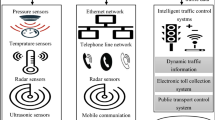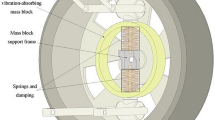Abstract
Vibration reduction is a significant problem in the design and construction of vehicle suspensions (Lozia and Zdanowicz, IOP Conf Ser Mater Sci Eng 148:12014, 2016; Konieczny et al., J Low Freq Noise Vib Act Control 32:81–98, 2013). Passive semi-active and active methods are used in order to reduce vibrations. Considerations related to active and semi-active vibration reduction and the influence of disturbances on such objects can be found in many publications. In the case of these systems, the aim is always to find a compromise between their efficiency and energy consumption. The control law for such systems is usually determined as a solution to the optimisation problem with quadrant quality indicator. Energy limitation is taken into account by selection coefficients of the weighting matrix associated with the control signals vector. The efficiency of vibration reduction is able to be improved in the entire useful frequency range of the system operation but this generally results in an increase in the demand for external energy. An additional problem in the case of vehicle suspensions includes the need for increased vibration reduction for selected frequencies. This is related to the internal vibration frequencies of the driver’s internal organs. The paper presents the synthesis of a weighted multitone optimal controller (WMOC) for an active vibration reduction system. The control signal in this case is determined on the basis of the identified sinusoidal disturbances vector. The vibration transmissibility function and the energetic indicators for the active suspension were determined while taking note of nonlinearities occurring in the actual vehicle. The analysis of energy indicators (e.g. energy, maximum power) is presented, depending on the level of vibration reduction efficiency. The results were compared with analogous linear-quadratic regulator (LQR).
Access provided by Autonomous University of Puebla. Download conference paper PDF
Similar content being viewed by others
Keywords
25.1 Control System with WMOC Controller
The WMOC (the WMOC is fully described in Refs. [3, 4]) controller determines optimal control signals only for sinusoidal components with frequencies \( {\omega}_1,\dots, {\omega}_{n_w} \). Having considered this, in case of the remaining frequencies the amplitude characteristics of the closed system remains unchanged. The control signal in the WMOC controllers is generated based on the state variables and the sinusoidal components of the disturbing signal (25.2). In order to calculate \( {u}_{\ast}^{(j)}(t) \) components of the control signal, it is necessary to determine the sinusoidal component vectors w(t) and the w ω (t) vector (25.3) in real time. In the applied method w j (t) signals are identified in the time interval \( \left[t-{T}_I^{(j)},t\right] \) (where \( {T}_I^{(j)} \) is the identification time and t is present moment of time) on the basis of the formulas (25.4)
The identification times \( {T}_I^{(j)} \) of individual components can be chosen independently of j. In practice, they are determined as the multiple of the identified w j (t) component period. The signals w j (t), w ω, j(t) for the present moment of time t are determined on the basis of formulas (25.5).
The tests were carried out for the active parallel suspension with WMOC control. The model of this suspension is 2-DOF. The Reference controller (REF) was determined using the LQR method. It was assumed that the determined controllers are to guarantee vibration reduction below −10 dB over the entire frequency range. Additionally, it was assumed that for arbitrarily selected frequencies (1, 2, 3, 4, 5 Hz), the vibration reduction should be greater and be at a level of at least −20 (dB). The vibration transfer functions for the designed controllers and the open loop feedback system are shown in Fig. 25.1. In the case of a reference controller, the need to provide vibration reduction of −20 dB for additional frequencies resulted in a necessity to increase the efficiency of vibration reduction over the entire frequency range to the level of −20 dB.
Figure 25.2 shows the comparison of the average energy E s, avg taken from the external power source for the WMOC controller and the reference controller. In the frequency range between 1.9 and 10.6 Hz, E s, avg takes negative values. For the WMOC controller in the frequency range between 1.9 and 10.6 Hz, E s, avg takes negative values, except for the specific frequencies of 3, 4 and 5 Hz. Taking this into consideration, the use of an efficient energy recovery system would allow for the reduction of vibrations at −10 dB level without an external power supply. The vibration transfer values for frequencies of 1, 2, 3, 4 and 5 Hz are below −20 dB. Therefore, the values E s, avg for these frequencies are greater than zero.
Conclusions based on the E s, avg analysis indicate the possibility of a significant reduction in energy use in the case of active suspension when using an energy recovery system; however, the construction of such systems is still being researched. The WMOC controller improves the vibration transfer function for selected frequencies while taking note of energy limitations. The control signal generated by the WMOC controller for these frequencies is optimal, making it possible to improve the vibration transmission function while limiting the amplitude of the force generated by the actuator element. The use of the WMOC controller allowed for reducing the requirements concerning the power generated by the actuator element compared to LQR controller when the assumed requirements regarding the vibration transfer function are met. The WMOC controller allowed for limiting the power consumption from external power sources, resulting in its reduced dimensions and price.
References
Lozia, Z., Zdanowicz, P.: Optimization of damping in the passive automotive suspension system with using two quarter-car models. IOP Conf. Ser. Mater. Sci. Eng. 148, 12014 (2016)
Konieczny, J., Kowal, J., Raczka, W., Sibielak, M.: Bench tests of slow and full active suspensions in terms of energy consumption. J. Low Freq. Noise Vib. Act. Control. 32, 81–98 (2013)
Tang, G.-Y., Gao, D.-X.: Approximation design of optimal controllers for nonlinear systems with sinusoidal disturbances. Nonlinear Anal. Theory Methods Appl. 66, 403–414 (2007)
Sibielak, M., Raczka, W., Konieczny, J., Kowal, J.: Optimal control based on a modified quadratic performance index for systems disturbed by sinusoidal signals. Mech. Syst. Signal Process. 64–65, 498–519 (2015)
Acknowledgements
This work was supported by National Centre for Research and Development of Poland (research project No. PBS3/B6/27/2015).
Author information
Authors and Affiliations
Corresponding author
Editor information
Editors and Affiliations
Rights and permissions
Copyright information
© 2019 The Society for Experimental Mechanics, Inc.
About this paper
Cite this paper
Rączka, W., Sibielak, M., Konieczny, J. (2019). Active Vehicle Suspension with a Weighted Multitone Optimal Controller: Considerations of Energy Consumption. In: Niezrecki, C., Baqersad, J. (eds) Structural Health Monitoring, Photogrammetry & DIC, Volume 6. Conference Proceedings of the Society for Experimental Mechanics Series. Springer, Cham. https://doi.org/10.1007/978-3-319-74476-6_25
Download citation
DOI: https://doi.org/10.1007/978-3-319-74476-6_25
Published:
Publisher Name: Springer, Cham
Print ISBN: 978-3-319-74475-9
Online ISBN: 978-3-319-74476-6
eBook Packages: EngineeringEngineering (R0)






